Logical Venn Diagrams: Exercise-2
- Statements:All plastics are steels.All steels are irons.No iron is a liquid.Conclusions:(I). All irons are steels.(II). All plastics are irons.
- If neither conclusion I nor conclusion II follows.
- If either conclusion I or conclusion II follows.
- If only conclusion I follows.
- If both the conclusion I and conclusion II follows.
- If only conclusion II follows.
Answer: (e) If only conclusion II follows.Solution: 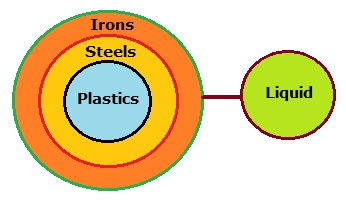 The first conclusion 'All irons are steels' is not possible but the second conclusion 'All plastics are irons' is possible.
The first conclusion 'All irons are steels' is not possible but the second conclusion 'All plastics are irons' is possible.
 The first conclusion 'All irons are steels' is not possible but the second conclusion 'All plastics are irons' is possible.
The first conclusion 'All irons are steels' is not possible but the second conclusion 'All plastics are irons' is possible.- Statements:No apple is a banana.All grapes are bananas.Some apples are mangoes.Conclusions:(I). Some mangoes are grapes.(II). Some grapes being apples is a possibility.
- If neither conclusion I nor conclusion II follows.
- If either conclusion I or conclusion II follows.
- If only conclusion I follows.
- If both the conclusion I and conclusion II follows.
- If only conclusion II follows.
Answer: (a) If neither conclusion I nor conclusion II follows.Solution: 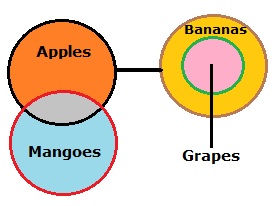 No conclusion is following the statements.
No conclusion is following the statements.
 No conclusion is following the statements.
No conclusion is following the statements.- Statements:All fans are coolers.All radios are coolers.Conclusions:(I). All coolers are fans.(II). Some radios being fans is a possibility.
- If neither conclusion I nor conclusion II follows.
- If either conclusion I or conclusion II follows.
- If only conclusion I follows.
- If both the conclusion I and conclusion II follows.
- If only conclusion II follows.
Answer: (e) If only conclusion II follows.Solution: 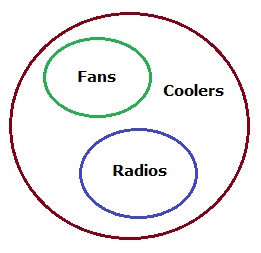 The first conclusion 'All coolers are fans' is not possible but it is possible that Some radios being fans.
The first conclusion 'All coolers are fans' is not possible but it is possible that Some radios being fans.
 The first conclusion 'All coolers are fans' is not possible but it is possible that Some radios being fans.
The first conclusion 'All coolers are fans' is not possible but it is possible that Some radios being fans.(4-5): Statements:
No bird is an animal.
All animal are monkeys.
Some monkeys are lions.
- Conclusions:(I). At least some animals are lions.(II). All birds being lions is a possibility.
- If neither conclusion I nor conclusion II follows.
- If either conclusion I or conclusion II follows.
- If only conclusion I follows.
- If both the conclusion I and conclusion II follows.
- If only conclusion II follows.
Answer: (d) If both the conclusion I and conclusion II follows.Solution: 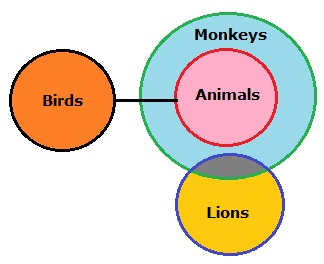 Folllow the figure given above.
Folllow the figure given above.
 Folllow the figure given above.
Folllow the figure given above.- Conclusions:(I). All monkeys can never be birds.(II). Some lions are definitely not birds.
- If neither conclusion I nor conclusion II follows.
- If either conclusion I or conclusion II follows.
- If only conclusion I follows.
- If both the conclusion I and conclusion II follows.
- If only conclusion II follows.
Answer: (a) If neither conclusion I nor conclusion II follows.Solution:  No conclusion is following the statements.
No conclusion is following the statements.
 No conclusion is following the statements.
No conclusion is following the statements.(6-7): Statements:
All flowers are fruits.
Some fruits are mangoes.
Some mangoes are apples.
- Conclusions:(I). All flowers can never be mangoes.(II). At least some apples are fruits.
- If neither conclusion I nor conclusion II follows.
- If either conclusion I or conclusion II follows.
- If only conclusion I follows.
- If both the conclusion I and conclusion II follows.
- If only conclusion II follows.
Answer: (e) If only conclusion II follows.Solution: 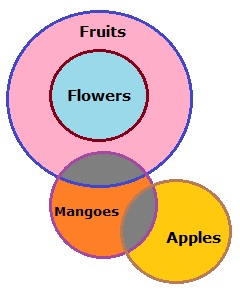 It is possible that at least some apples are fruits, but the first conclusion 'All flowers can never be mangoes' not follows the statements.
It is possible that at least some apples are fruits, but the first conclusion 'All flowers can never be mangoes' not follows the statements.
 It is possible that at least some apples are fruits, but the first conclusion 'All flowers can never be mangoes' not follows the statements.
It is possible that at least some apples are fruits, but the first conclusion 'All flowers can never be mangoes' not follows the statements.- Conclusions:(I). All flowers being apples is a possibility.(II). No fruit is a apple.
- If neither conclusion I nor conclusion II follows.
- If either conclusion I or conclusion II follows.
- If only conclusion I follows.
- If both the conclusion I and conclusion II follows.
- If only conclusion II follows.
Answer: (c) If only conclusion I follows.Solution:  It is possible that all flowers being apples, but the second conclusion 'No fruit is a apple' not follows the statements.
It is possible that all flowers being apples, but the second conclusion 'No fruit is a apple' not follows the statements.
 It is possible that all flowers being apples, but the second conclusion 'No fruit is a apple' not follows the statements.
It is possible that all flowers being apples, but the second conclusion 'No fruit is a apple' not follows the statements.(8-10): Statements:
All boys are girls.
All girls are womwn.
- Conclusions:(I). Some women are boys.(II). Some girls are boys.
- If neither conclusion I nor conclusion II follows.
- If either conclusion I or conclusion II follows.
- If only conclusion I follows.
- If both the conclusion I and conclusion II follows.
- If only conclusion II follows.
Answer: (d) If both the conclusion I and conclusion II follows.Solution: 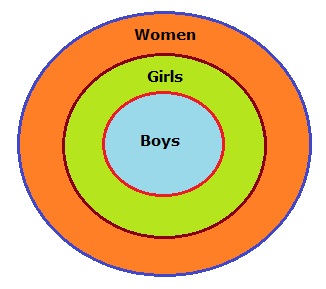 Both the conclusions are following the statements.
Both the conclusions are following the statements.
 Both the conclusions are following the statements.
Both the conclusions are following the statements.- Conclusions:(I). All boys are women.(II). Some boys are not girls.
- If neither conclusion I nor conclusion II follows.
- If either conclusion I or conclusion II follows.
- If only conclusion I follows.
- If both the conclusion I and conclusion II follows.
- If only conclusion II follows.
Answer: (c) If only conclusion I follows.Solution:  It is possible that all boys are women, but the second conclusion 'Some boys are not girls' not follows the statements.
It is possible that all boys are women, but the second conclusion 'Some boys are not girls' not follows the statements.
 It is possible that all boys are women, but the second conclusion 'Some boys are not girls' not follows the statements.
It is possible that all boys are women, but the second conclusion 'Some boys are not girls' not follows the statements.- Conclusions:(I). All girls are boys.(II). Some women are girls.
- If neither conclusion I nor conclusion II follows.
- If either conclusion I or conclusion II follows.
- If only conclusion I follows.
- If both the conclusion I and conclusion II follows.
- If only conclusion II follows.
Answer: (e) If only conclusion II follows.Solution:  It is possible that some women are girls, but the first conclusion 'All girls are boys' not follows the statements.
It is possible that some women are girls, but the first conclusion 'All girls are boys' not follows the statements.
 It is possible that some women are girls, but the first conclusion 'All girls are boys' not follows the statements.
It is possible that some women are girls, but the first conclusion 'All girls are boys' not follows the statements.